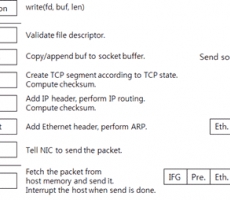-
Read MoreNo Image
Understanding Vert.x Architecture - Part I: Inside Vert.x. Comparison with Node.js
Written by Seongmin Woo on 06/14/2017 Vert.x is a server framework that is rapidly arising. Each server framework claims its strong points are high performance with a variety of protocols supported. Vert.x takes a step forward from that. Vert.x considers the environment of establishing and operating the server network environment. In other words, Vert.x includes careful consideration in producing several 'server process DAEMONs' that run on the clustering environment, as well as producing one server process DAEMON. Therefore, it is important to review Vert.x: which network environment it considers as well as how it delivers high performance. So, I think it will be valuable to pay sufficient time examining Vert.x structure. Philosophy of Vert.x Vert.x is a project affected by Node.js. Like N... -
Read More

Understanding TCP/IP Network Stack & Writing Network Apps
Written by Hyeongyeop Kim on 06/09/2017 We cannot imagine Internet service without TCP/IP. All Internet services we have developed and used at NHN are based on a solid basis, TCP/IP. Understanding how data is transferred via the network will help you to improve performance through tuning, troubleshooting, or introduction to a new technology. This article will describe the overall operation scheme of the network stack based on data flow and control flow in Linux OS and the hardware layer. Key Characteristics of TCP/IP How should I design a network protocol to transmit data quickly while keeping the data order without any data loss? TCP/IP has been designed with this consideration. The following are the key characteristics of TCP/IP required to understand the concept of the stack. TCP and IP ... -
Read More

Understanding JDBC Internals & Timeout Configuration
Written by Woon Duk Kang on 06/07/2017 An application with a proper JDBC timeout can cut down the failure time. In this article, we would like to talk about different kinds of timeout values and recommended timeout application methods when you import values from DBMS. Web Application Server became unresponsive after a DDoS attack one day (This is a close reconstitution of an actual event.) The entire service did not work normally after a DDoS attack. The network was disconnected because L4 was not working, which caused WAS to be inoperable as well. Shortly afterward, the security team blocked all DDoS attacks and restored the network back to normal. Yet, WAS was still not working. Through the ThreadDump of WAS, the service team was able to confirm that WAS had stopped during API call from... -
Read More

Become a Jave GC Expert Series 3 : How to Tune Java Garbage Collection
Written by Sangmin Lee on 06/02/2017 This is the third article in the series of "Become a Java GC Expert". In the first issue Understanding Java Garbage Collection we have learned about the processes for different GC algorithms, about how GC works, what Young and Old Generation is, what you should know about the 5 types of GC in the new JDK 7, and what the performance implications are for each of these GC types. In the second article How to Monitor Java Garbage Collection I have explained how JVM actually runs the Garbage Collection in the real time, how we can monitor GC, and which tools we can use to make this process faster and more effective. In this third article based on real cases as our examples I will show some of the best options you can use for GC tuning. I have written this arti... -
Read MoreNo Image
Become a Jave GC Expert Series 2 : How to Monitor Java Garbage Collection
Written by Sangmin Lee on 06/01/2017 This is the second article in the series of "Become a Java GC Expert". In the first issue Understanding Java Garbage Collection we have learned about the processes for different GC algorithms, about how GC works, what Young and Old Generation is, what you should know about the 5 types of GC in the new JDK 7, and what the performance implications are for each of these GC types. In this article, I will explain how JVM is actually running Garbage Collection in the real time. What is GC Monitoring? Garbage Collection Monitoring refers to the process of figuring out how JVM is running GC. For example, we can find out: when an object in young has moved to old and by how much, or when stop-the-world has occurred and for how long. GC monitoring is carried out t...



